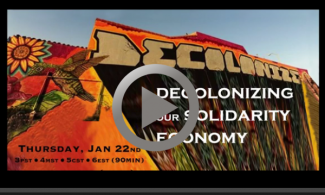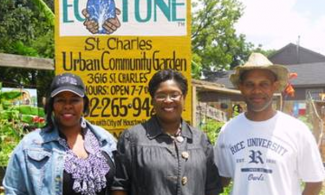
Time closed the door on a No Good, Horrible, Very Bad year, and what we stepped out to is a different future to craft. Worker cooperatives, or employee-owned and managed firms, may be a large part of a more humanist and ecological future, if their proponents have a say. Because they de-concentrate ownership and spread control to people with multiple motives and purposes, worker coops could shift the business decision-calculus to one that better balances profit with human needs and that is more reticent to destroy the physical landscape supporting home, work, and community. At the right tipping point, who knows? Worker coops could alter the logic of capitalism and mitigate its many harms.
Our contemporaries aren’t the first to think cooperation is a main ingredient to a better economy. I spoke with Prof. Jessica Gordon-Nembhard, author of Collective Courage: A History of African-American Cooperative Economic Thought and Practice, who explained the importance of cooperatives to the Knights of Labor’s strategy for a more just and inclusive economy. Active between 1869 and about 1890, the Knights wanted to create a cooperative commonwealth with labor owning plants and firms. They “understood that white labor couldn’t really succeed without coalitions with Black labor,” Gordon-Nembhard explained, “ because otherwise they would just bid the two against each other.” So, even in the Jim Crow South, where there were overt laws against inter-racial association, the Knights were deeply inclusive.
As Gordon-Nembhard recounted, the Knights of Labor actively formed about 200 worker coops while they were active. And much like coop developers aspire to do today, the Knights of Labor and some analogous organizations also endeavored to build up economies of scale and sources of capital under their control. The Colored Farmers National Alliance, for instance, created “exchanges” that sold goods in bulk and extended credit to black farmers to buy their own land.
This inter-racial move toward cooperation and self-control came to a halt as capitalists and white supremacists used their power advantages against the Knights and other labor organizations. Probably well known about the era is the intense strikebreaking backed by the courts- and even the U.S. military in some instances -that weakened unions such as the Knights. To weaken them further, the railroad barons were able to refuse to transport product made by union workforces or the worker coops developed by unions. In the South, the Ku Klux Klan reinforced capitalist anti-union fury by targeting integrated or Black unions, lynching their leaders, and burning worker coop businesses to the ground. The Knights of Labor and many of their offshoots were defeated by 1890 or 1900. The movement was squashed.
It’s hard to imagine such fervor against worker cooperatives today but, with significant proliferation or certain types of policy advocacy, conventional businesses could come to perceive a threat. Is getting squashed something the contemporary worker coop movement needs to worry about?
“Luckily,” said Gordon-Nembhard, “we don’t have really have a terrorist group like the Ku Klux Klan anymore; we don’t have that total overt violence that was a huge part of the downfall of those (19th century organizations promoting worker coops).”
If violence is unlikely to bring contemporary coops down today, social and political factors could be a concern. In her historical analysis, Gordon-Nembhard found that “Coops and coop movements that were the strongest were the ones that had broad support from other community members and from national organizations.” This is because communities that valued coops would support and protect them when threats appeared. National organizations had money and would aid local branches in trouble. Ultimately, in the 19th century, the alliances supporting cooperatives did fall apart. As Gordon-Nembhard explained, “When the labor unions split away from the coop movement and the coop movement and the labor movement split away from integration, I think they all became weaker” in the face of incredible opposition.
Gordon-Nembhard’s takeaway for coops right now is the importance of “eternal vigilance, in terms of not letting us separate the parts.” The “parts” she emphasized in our interview include the coops, of course, but also community, politicians, and linkages between coops. Communities might not know the value of coops, how they typically stay anchored in place, how they recycle money locally, how they spin other local opportunities. Gordon-Nembhard wants to see strengthened commitment to educating the public about coops, since communities seeing how coops add value are more likely to help them succeed.
Elected officials also need to be educated. As she said, “I really think one of things we’re not doing as good a job at is getting our elected officials to understand the benefits of coops.” She believes strength will come from cities or even government at other scales investing public resources in coop education and financing, as a number of cities have started to do. The public sector can be an ally in a contemporary coalition to support worker coops.
A third part to fortifying worker coops is what Gordon-Nembhard calls “a coop commonwealth,” or linking coops together in supply chains. For instance, a bicycle coop securing parts from coops making wheels, or a food coop selling produce grown at an urban garden, and right on down the line could mean, as she says, “the coops have less and less dependence on the capitalist companies that might be trying to undermine them.” Keeping the door open to an economy rooted in cooperation is not something worker cooperatives can do in isolation, and strength will come through inward and outward linkages.




Add new comment